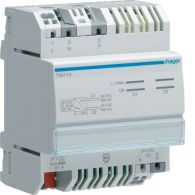Operation of a KNX Power Supply
Building automation is constantly evolving, and the KNX protocol is one of the pillars of this transformation, being widely used for controlling and monitoring devices in smart homes and buildings. An essential component of the KNX system is the power supply, which not only provides energy but also enables communication between the devices connected to the bus. In this article, I will explain in detail how a KNX power supply works, highlighting its features and the importance of the signal generator and galvanic isolation.
The Role of the KNX Power Supply
The KNX power supply is a fundamental device in the automation system, responsible for providing energy to the KNX bus and ensuring communication between the devices. The KNX bus functions as a communication line where switches, sensors, actuators, and other devices exchange information. Without an adequate power supply, the KNX system would not work, as the devices need power to operate and communicate.
Components and Operation of the KNX Power Supply
1. Power Supply to the Bus:
- The KNX power supply converts the electrical network voltage (usually 230V AC) to a 30V DC voltage, which is the standard for the KNX bus. This conversion is essential to power all the devices connected to the system, maintaining stable and safe operation.
2. Signal Generator:
- In addition to providing power, the KNX power supply contains a signal generator that creates a current modulation on the bus. This modulated signal is responsible for bidirectional communication between devices.
- The signal generator uses a modulation technique called "current mode communication," where small current variations represent data bits. These variations are superimposed on the 30V DC voltage, allowing communication and power to share the same cable, simplifying system installation and maintenance.
- The signal generator's function is crucial because, without it, KNX devices would not be able to "talk" to each other. This signal is the basis of all system communication, ensuring that commands are transmitted correctly and that the system operates in a synchronized and efficient manner.
3. Galvanic Isolation:
- Most KNX power supplies include galvanic isolation to electrically separate the power network from the bus side. Galvanic isolation is a technique that uses transformers, optocouplers, or capacitors to prevent any direct current contact between the two parts of the circuit.
- This isolation provides protection against electric shocks, voltage surges, and other electrical problems that could affect the bus and connected devices. It is an essential safety measure, especially in automation systems where device reliability and protection are crucial.
4. Integrated Protections:
- KNX power supplies include various protections, such as against short circuits, overloads, and overvoltage. These protections ensure that the system is not damaged in case of failures, guaranteeing the longevity of the connected devices.
5. Load Capacity:
- KNX power supplies are available in different capacities, generally classified by the maximum current they can provide (160 mA, 320 mA, 640 mA, etc.). The choice of power capacity should be based on the number of devices and their energy needs. An undersized power supply can lead to system failures, while an oversized one represents a waste of resources.
6. Diagnostic LEDs:
- Many KNX power supplies have diagnostic LEDs that indicate the operational status of the power supply, such as the presence of correct voltage, communication failures, or bus problems. These indicators make it easier to identify and solve problems during installation and maintenance.
Importance of the Signal Generator in the KNX Power Supply
The signal generator is the heart of the KNX communication system. It ensures that devices can send and receive information reliably. The KNX protocol uses a bus access method that avoids signal collisions, ensuring that only one device transmits at a time, preventing interference and guaranteeing data integrity.
Additionally, the signal generator supervises the bus line to detect problems, such as short circuits or communication failures, triggering protection mechanisms if problems are detected. This continuous supervision is essential for maintaining system stability.
The Role of Galvanic Isolation
Galvanic isolation plays several important roles in the context of a KNX power supply:
- Protection of Equipment and People: It prevents electrical faults on the power side from propagating to the bus, protecting connected devices and the people interacting with the system.
- Redução de Interferências: It helps minimize the spread of electrical noise and interference, improving communication reliability between devices.
- Electrical Safety: By eliminating the direct current connection between the isolated parts, galvanic isolation prevents electric shocks and other associated risks.
Summary
The KNX power supply is much more than a simple energy transformer; it is a sophisticated component that combines electrical power with a robust communication infrastructure. The signal generator and galvanic isolation play essential roles in the system's reliability and safety, ensuring efficient and safe operation. With an appropriate KNX power supply, it is possible to create robust automation systems capable of efficiently managing communication between devices and ensuring the smooth operation of smart buildings.
Understanding the operation of a KNX power supply is crucial for those working with automation systems, as it allows for optimizing installation, maintenance, and troubleshooting, ensuring the system operates as efficiently and safely as possible.
Image Gallery - Hager KNX Power Supply TXA111
Image Gallery - Hager KNX Power Supply TXA114
Technical Documentation TXA111 [EN]

Fonte alimentação KNX 320mA • TXA111 | Hager
Documentação Técnica TXA114 [PT]




































Comments